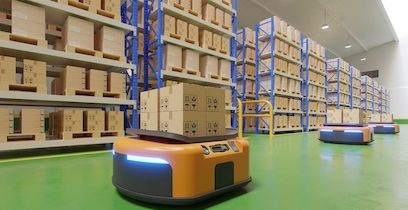Warehouse Robots and the New Normal
Guest Blog by MHI Members, FORT Robotics
As the world continues to adjust to the challenges posed by COVID-19, robots are playing an increasingly important role in getting goods to the people who need them.
The pandemic has placed a huge burden on warehousing operations. Stay-at-home orders and health concerns have driven shoppers away from brick and mortar retail to e-commerce alternatives, with online retail sales up as much as 76% over last year. At the same time, the workforce remains compromised as workers stay at home to manage health and childcare. The situation has led to a surge in warehouse automation, and it looks like robots will be a crucial part of the new normal for the supply chain.
High Demand, Rapid Growth
Warehouse automation technology was on the rise well before the COVID outbreak. To alleviate the effects of labor shortages and keep up with the demands of e-commerce, solutions like automatic guided vehicles (AGVs), autonomous mobile robots (AMRs), automated forklifts and robotic storage and retrieval systems have seen rapid growth. A report from Logistics IQ predicted that the warehouse automation market, valued at $13 billion in 2018, would likely increase to $27 billion by 2025.
COVID has accelerated this already robust growth, with companies relying more heavily on robotic solutions to fulfill online shopping orders. Retailers are speeding up existing plans for automation–apparel giant Gap is working with Kindred AI to triple its number of piece-picking robots by autumn. On the delivery side of the supply chain, UPS recently unveiled its new warehouse execution system which includes a pilot program integrating autonomous mobile robots from Locus Robotics.
In a Robotic Industries Association discussion on COVID and autonomous mobile robots, Locus Robotics CEO Richard Falk described how the pandemic has shifted the way many decision-makers think about automation: “About three years ago… leaders would say ‘I’m not going to stick my job on the line to automate.’ And now what we’re finding, it’s really just the opposite: ‘If I don’t automate, and I don’t move in this direction, I don’t have a vision. Then, my job is on the line.’”
Social Distancing
In the close quarters of a warehouse, it can be challenging if not impossible for employees to work within new social distancing guidelines. Mobile robots can help people stay farther apart by literally filling in the gaps: transferring goods throughout the facility, receiving, shelving, packaging and acting as go-betweens. We’ve learned how quickly the virus can spread through facilities where workers are in close proximity, and robots could be a key to halting similar outbreaks.
Robots can also help warehouses maintain productivity with smaller teams by helping to make the best use of limited workers. “If you’re going to have limited people in the building, the last thing you want them to do is a simple task that can be automated,” Righthand Robotics’s Vince Martinelli said in a recent interview. In some cases, cloud-based robotic systems even make remote work a possibility, allowing team members to supervise work while staying out of high-risk areas.
Keeping Safety and Security Top of Mind
While robots have the potential to mitigate the risk of COVID spread, they can also alleviate other warehouse safety hazards. Workers can be safer and reduce the risk of injury as robots take over heavy lifting, pulling carts, repetitive tasks and dangerous work. Autonomous mobile robots may help reduce the nearly 97,000 forklift-related injuries that occur each year.
But robots can pose their own safety and security risks if they are not deployed properly. In the coming months, many workplaces will see hundreds of new robots working alongside their human coworkers. This is a crucial time to ensure that functional safety is built into robotic operations from the beginning, so that autonomous systems can be safely stopped and managed at scale. Cybersecurity protocols also need to be in place to ensure that connected machines can’t be hacked or tampered with by internal or external bad actors – an increasingly important consideration as more machines become connected to the cloud. Risk assessments and functional safety standards can help warehouse operators and integrators better plan for and mitigate these potential threats to safely implement their autonomous systems.
As we continue to discover a new normal on the warehouse floor and beyond, it’s clear that robots are going to be a crucial part of the recovery for many businesses. With the right protection systems in place, robots and their human coworkers can collaborate to enable a safer, more productive, and healthier supply chain.





